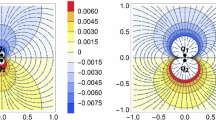Abstract
We develop a systematic approach to calculating the electrostatic force between point charges in an arbitrary domain with arbitrary boundary conditions. When the boundary is present, the simple expression for the force acting on a charge as “the charge times the field it is placed in” becomes ill-defined. However, this rule can be salvaged if the field in question is redefined to only include all terms that do not diverge at the charge position, in particular, those due to the charge itself. The proof requires handling the self-action energy divergence for point charges, which is accomplished by means of a geometrical regularization.
Similar content being viewed by others
References
A. J. W. Sommerfeld, Electrodynamics (Academic Press, New York, 1952; Inostrannaya Literatura, 1958).
I. E. Tamm, The Principles of Electricity Theory (GITTL, Moscow, 1957).
J. A. Stratton, Electromagnetic Theory (McGraw-Hill, New York, 1941; Gostekhizdat, Moscow, 1948).
L. D. Landau and E. M. Lifshitz, The Classical Theory of Fields, 4th ed. (GIFML, Moscow, 1962; Pergamon, Oxford, 1975).
L. D. Landau and E. M. Lifshitz, Course of Theoretical Physics, Vol. 8: Electrodynamics of Continuous Media, 2nd ed. (Nauka, Moscow, 1982; Pergamon, New York, 1984).
W. R. Smythe, Static and Dynamic Electricity (Hemisphere, New York, 1989).
J. D. Jackson, Classical Electrodynamics (Wiley, New York, 1999).
R. P. Feynman, The Feynman Lectures on Physics, Vol. 2: Electromagnetism and Matter (Addison-Wesley, Redwood City, 1989).
J. M. Crowley, Fundamentals of Applied Electrostatics (Wiley, New York, 1986).
Electrostatics and Its Applications, Ed. by A. D. Moore (Wiley, New York, 1973).
R. Mittra and S. W. Lee, Analytical Techniques in the Theory of Guided Waves (Springer, Berlin, 1967).
V. M. Mostepanenko and N. N. Trunov, The Casimir Effect and Its Applications (Clarendon, Oxford, 1997).
V. I. Smirnov, A Course of Higher Mathematics (GITTL, Moscow, 1957; Addison-Wesley, Reading, Mass., 1964), Vol. 4.
O. D. Kellogg, Foundations of Potential Theory (Macmillan, New York, 1971).
M. Tinkham, Introduction to Superconductivity (McGraw-Hill, New York, 1996).
I. M. Nemenman and A. S. Silbergleit, J. Appl. Phys. 86, 614 (1999).
Author information
Authors and Affiliations
Additional information
From Zhurnal Tekhnichesko\(\overset{\lower0.5em\hbox{$\smash{\scriptscriptstyle\smile}$}}{l}\) Fiziki, Vol. 73, No. 2, 2003, pp. 13–18.
Original English Text Copyright © 2003 by Silbergleit, Nemenman, Mandel.
This article was submitted by the authors in English.
Rights and permissions
About this article
Cite this article
Silbergleit, A., Nemenman, I. & Mandel, I. On the interaction of point charges in an arbitrary domain. Tech. Phys. 48, 146–151 (2003). https://doi.org/10.1134/1.1553553
Received:
Issue Date:
DOI: https://doi.org/10.1134/1.1553553




